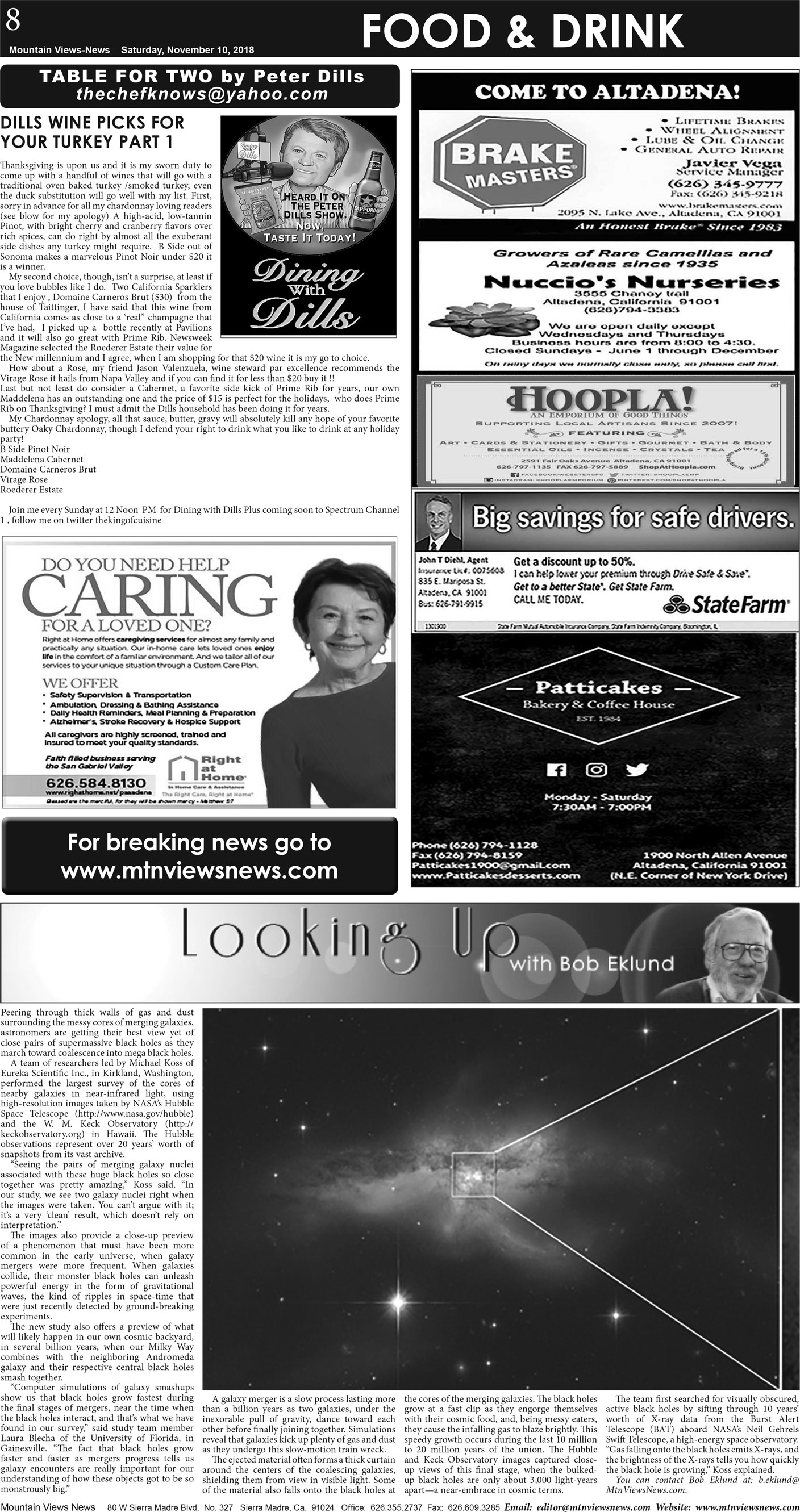| Food, Drink & More | ||||||||||||||||||||
| Mountain Views News, Sierra Madre Edition [Pasadena] Saturday, November 10, 2018 | ||||||||||||||||||||
| ||||||||||||||||||||
|
8 FOOD & DRINK Mountain Views-News Saturday, November 10, 2018 TABLE FOR TWO by Peter Dills thechefknows@yahoo.com DILLS WINE PICKS FOR YOUR TURKEY PART 1 Thanksgiving is upon us and it is my sworn duty to come up with a handful of wines that will go with a traditional oven baked turkey /smoked turkey, even the duck substitution will go well with my list. First, sorry in advance for all my chardonnay loving readers (see blow for my apology) A high-acid, low-tannin Pinot, with bright cherry and cranberry flavors over rich spices, can do right by almost all the exuberant side dishes any turkey might require. B Side out of Sonoma makes a marvelous Pinot Noir under $20 it is a winner. My second choice, though, isn’t a surprise, at least if you love bubbles like I do. Two California Sparklers that I enjoy , Domaine Carneros Brut ($30) from the house of Taittinger, I have said that this wine from California comes as close to a ‘real” champagne that I’ve had, I picked up a bottle recently at Pavilions and it will also go great with Prime Rib. Newsweek Magazine selected the Roederer Estate their value for the New millennium and I agree, when I am shopping for that $20 wine it is my go to choice. How about a Rose, my friend Jason Valenzuela, wine steward par excellence recommends the Virage Rose it hails from Napa Valley and if you can find it for less than $20 buy it !! Last but not least do consider a Cabernet, a favorite side kick of Prime Rib for years, our own Maddelena has an outstanding one and the price of $15 is perfect for the holidays, who does Prime Rib on Thanksgiving? I must admit the Dills household has been doing it for years. My Chardonnay apology, all that sauce, butter, gravy will absolutely kill any hope of your favorite buttery Oaky Chardonnay, though I defend your right to drink what you like to drink at any holiday party! B Side Pinot Noir Maddelena Cabernet Domaine Carneros Brut Virage Rose Roederer Estate Join me every Sunday at 12 Noon PM for Dining with Dills Plus coming soon to Spectrum Channel 1 , follow me on twitter thekingofcuisine Peering through thick walls of gas and dust surrounding the messy cores of merging galaxies, astronomers are getting their best view yet of close pairs of supermassive black holes as they march toward coalescence into mega black holes. A team of researchers led by Michael Koss of Eureka Scientific Inc., in Kirkland, Washington, performed the largest survey of the cores of nearby galaxies in near-infrared light, using high-resolution images taken by NASA’s Hubble Space Telescope (http://www.nasa.gov/hubble) and the W. M. Keck Observatory (http:// keckobservatory.org) in Hawaii. The Hubble observations represent over 20 years’ worth of snapshots from its vast archive. “Seeing the pairs of merging galaxy nuclei associated with these huge black holes so close together was pretty amazing,” Koss said. “In our study, we see two galaxy nuclei right when the images were taken. You can’t argue with it; it’s a very ‘clean’ result, which doesn’t rely on interpretation.” The images also provide a close-up preview of a phenomenon that must have been more common in the early universe, when galaxy mergers were more frequent. When galaxies collide, their monster black holes can unleash powerful energy in the form of gravitational waves, the kind of ripples in space-time that were just recently detected by ground-breaking experiments. The new study also offers a preview of what will likely happen in our own cosmic backyard, in several billion years, when our Milky Way combines with the neighboring Andromeda galaxy and their respective central black holes smash together. “Computer simulations of galaxy smashups show us that black holes grow fastest during the final stages of mergers, near the time when the black holes interact, and that’s what we have found in our survey,” said study team member Laura Blecha of the University of Florida, in Gainesville. “The fact that black holes grow faster and faster as mergers progress tells us galaxy encounters are really important for our understanding of how these objects got to be so monstrously big.” A galaxy merger is a slow process lasting more than a billion years as two galaxies, under the inexorable pull of gravity, dance toward each other before finally joining together. Simulations reveal that galaxies kick up plenty of gas and dust as they undergo this slow-motion train wreck. The ejected material often forms a thick curtain around the centers of the coalescing galaxies, shielding them from view in visible light. Some of the material also falls onto the black holes at the cores of the merging galaxies. The black holes grow at a fast clip as they engorge themselves with their cosmic food, and, being messy eaters, they cause the infalling gas to blaze brightly. This speedy growth occurs during the last 10 million to 20 million years of the union. The Hubble and Keck Observatory images captured close- up views of this final stage, when the bulked- up black holes are only about 3,000 light-years apart—a near-embrace in cosmic terms. The team first searched for visually obscured, active black holes by sifting through 10 years’ worth of X-ray data from the Burst Alert Telescope (BAT) aboard NASA’s Neil Gehrels Swift Telescope, a high-energy space observatory. “Gas falling onto the black holes emits X-rays, and the brightness of the X-rays tells you how quickly the black hole is growing,” Koss explained. You can contact Bob Eklund at: b.eklund@ MtnViewsNews.com. Mountain Views News 80 W Sierra Madre Blvd. No. 327 Sierra Madre, Ca. 91024 Office: 626.355.2737 Fax: 626.609.3285 Email: editor@mtnviewsnews.com Website: www.mtnviewsnews.com | ||||||||||||||||||||



















